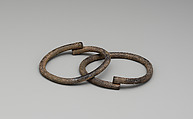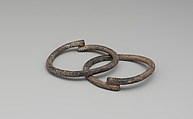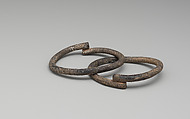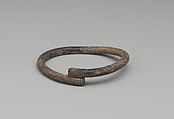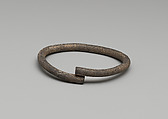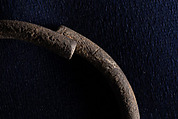On loan to The Met The Met accepts temporary loans of art both for short-term exhibitions and for long-term display in its galleries.
Silver bracelets
Technical analysis: X-ray radiography, ultraviolet-induced visible luminescence and raking light examination, optical microscopy, XRF
Each bracelet is made of a rod with overlapping terminals that has been shaped into an oval. The terminals are decorated with shallow incised lines that are set back slightly from the end of the rod and contained by a circumferential line at either end. The surface of both bracelets is covered with silver bromide corrosion.
When the bracelets were acquired by Leonard Stern they were identified as electrum, a naturally occurring alloy of gold and silver. However, XRF analysis in the Met’s laboratory makes clear that the bracelets are made of unalloyed silver. It would have been exceptional to find such a significant amount of electrum used for an Early Cycladic bracelet but silver is much more common and could be locally sourced on the island of Siphnos or at Lauvrion in Attica. Good parallels for these bracelets have been excavated at the Early Bronze Age cemetery at Petras in eastern Crete, which is near to the Early Cycladic site of Agia Photia, one of the few places on Crete where Cycladic people are known to have settled. The bracelets from Petras also have overlapping terminals although without further decoration and they exhibit a similar distinctive silver bromide corrosion.(1)
Seán Hemingway, Dorothy Abramitis, Federico Carò
(1) See A. Giumlia-Maier, P.P. Betancourt, Susan C. Ferrence and J.D. Muhly, "Special Silver Alloys from the Pre- and Proto-palatial Cemetery of Petras, Crete," in M. Tsipopoulou, ed., Petras, Siteia. The Pre- and Proto-palatial cemetery in context (Monograph of the Danish Institute in Athens, Volume 21 (Denmark: Aarhus University Press, 2017), pp. 203-213, esp. fig. 1. There are four silver bracelets, probably all dated to the Early Cycladic II period, in the Ashmolean Museum that are said to be from Amorgos, some of which include similar incised decoration near the terminals. See S. Sherratt, Catalogue of Cycladic Antiquities in the Ashmolean Museum. The Captive Spirit. I-II. Illustrations (Oxford: Oxford University Press, 2000), pp.96-99, pls. 64-67.
Due to rights restrictions, this image cannot be enlarged, viewed at full screen, or downloaded.
This artwork is meant to be viewed from right to left. Scroll left to view more.
